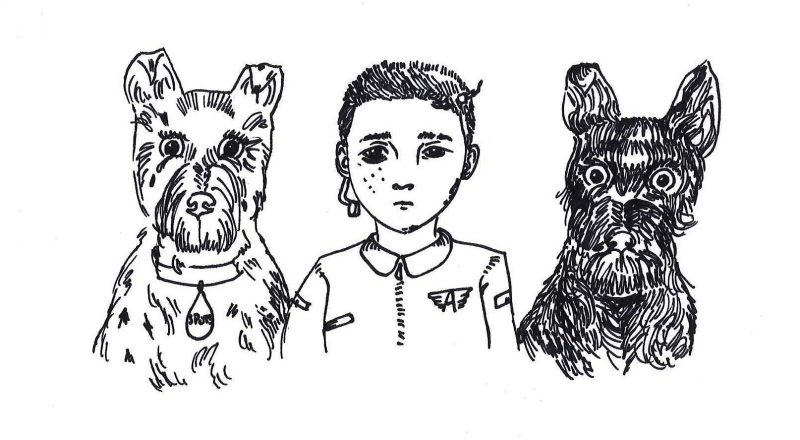The hardest part of watching a movie with significant hype is avoiding disappointment. Hype comes from both from outside sources and personal expectations, and it can cause you to not even be able to enjoy something because your mind is primed to focus on the things both loved and hated by others.
I swear I tried to avoid these predispositions before watching “Isle of Dogs.” But legacy weighs heavily on the buzz around Wes Anderson’s ninth film, his second in stop-motion.
Personally, I couldn’t help but be excited last year when it was announced, being a fan not only of Anderson but also, in a shocking twist, dogs as well. But I also felt apprehension towards Anderson using Japanese animation and culture to tell a story that is penned and directed by, and starring the voices of, white people.
The basic plot of this movie finds all dogs exiled out of a fictitious Japanese city to an island of trash. Atari, the orphaned ward of the city’s authoritarian mayor, is on a journey to find his exiled dog. He is joined by Chief, a former stray who is not used to taking commands from humans.
If this plot had been the sole focus of “Isle of Dogs,” my thoughts towards its approach to Japanese culture might have been different. Though Atari’s words are never translated from Japanese to English, the character’s growth with Chief is clearly communicated through his eyes, due in no small part to Anderson’s knack for visual expression.
There’s no denying that this is a stunning, visually captivating film that departs from the warm look of “Fantastic Mr. Fox,” influenced by Japanese directors Akira Kurosawa and Studio Ghibli’s Hayao Miyazaki. There is a surprising amount of blank spaces and drab colors in this film, especially in sequences shot on Trash Island, which are a welcome change of pace from the saturation of Anderson’s last two films, “Grand Budapest Hotel” and “Moonrise Kingdom.”
But when Anderson ventures out of the wide, open spaces of Trash Island, the film becomes less enjoyable. Many reviewers have argued that the Japan of “Isle of Dogs” is merely a token, a plot device to serve as a fun and exciting backdrop for white characters to be quirky and generally Wes Anderson-esque.
This isn’t helped by the film’s incomprehensible choice to not use subtitles for Japanese dialogue, instead using American dubbing when it was absolutely necessary to translate the dialogue. For the most part, the Japanese characters speak without translation, while the canonically Japanese dogs all speak a crisp canine American English. This choice is bizarre as it only serves to make the Japanese characters more foreign to the audience, denying any chance for complexity within the human world of the city.
It’s equally bizarre that, though the film has a huge cast and Atari is accompanied by a group of five dogs on his journey, there are only two major roles voiced by women. Nutmeg is the sole speaking female dog, voiced by Scarlett Johansson, and is limited to the tired role of sidelined girlfriend, a prize at the end of the journey for our hero Chief and little else.

The other female character Tracy Walker, voiced by Greta Gerwig, is a classmate of Atari that serves as the hero in the second storyline of the film, fighting for justice on behalf of the flu-ridden dogs. If you couldn’t tell from her name, Tracy is not Japanese, but instead a white exchange student from Ohio who sports a blonde afro and speaks English throughout the film.
Though much of her dialogue is unimportant to the emotional core of the storyline involving Atari’s search for his dog, we are regrettably allowed to understand her without the language barrier separating us from Atari. It’s personally excruciating that Anderson made me dislike not only the film’s only major — if you can even call it that — female role but also the one voiced by Greta Gerwig.
I tried my hardest not to be disappointed in “Isle of Dogs,” but its choices in language and plotting were a major misstep for me. Look, I’m not made of stone. I definitely miss my dog after watching this. I, along with probably every other viewer, want that earpiece that Atari shared with his dog to be real, so that my dog could hear my annoying voice in surround-sound dog-English, constantly telling her how much I love her.
But the film could have pulled these emotional strings without the orientalist setting, the white-savior second storyline and the lack of subtitles, which all only served to further alienate non-Japanese viewers from the Japanese characters.
The best part of “Isle of Dogs” was trudging through trash against a backdrop of dark political forces and a feline-friendly administration, a concept that isn’t all that foreign, especially to any Trinity student.








vivek • Sep 5, 2019 at 9:11 pm
first of all, don’t put your pic( which is bigger than your article) in your article..it’s not your face, it’s your work that will make you a good media person. I heard it right u Americans are raising a generation of snowflakes who don’t want to do anything and whine about everything without realizing how privileged your life is. The movie appeals to you to learn Japanese culture, it motivates you to go out there with some Japanese girl or guy and learn their language, communicate with them and the movie will provide you that initial platform.
Dan O'Neill • Apr 17, 2018 at 4:59 am
Not one of Anderson’s best for sure. But still pretty enjoyable. Nice review.